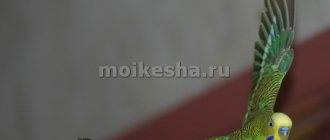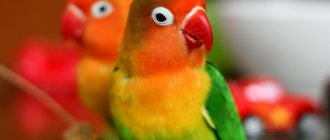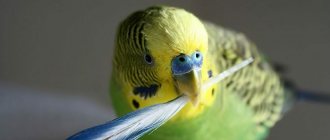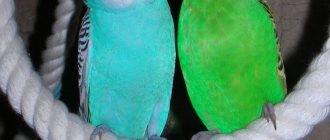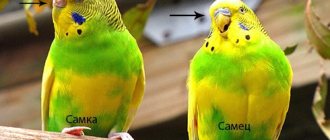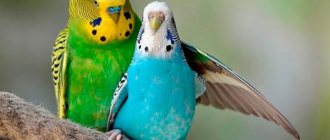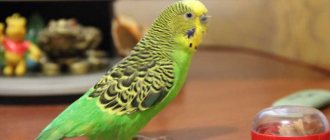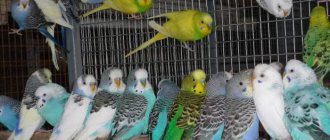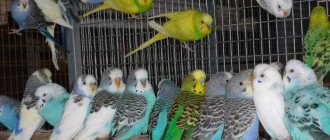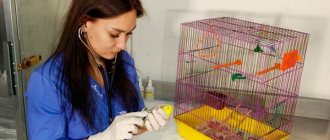Before purchasing a parrot, you need to find out how old the parrot is. Buying a young individual will allow you to live a long and bright life together. Birds do not have the longest life expectancy, so you don’t want to lose several years simply because what was initially purchased was not a chick, but an adult, which is why you need to know how to distinguish an old parrot from a young one. Recent chicks adapt to new owners more quickly and are also more likely to learn.
Age of a parrot by human standards
People who want to buy a feathered pet, before buying, think about how old the parrot is, which may have been living in an apartment for a long time, or about the age of the bird that is just about to adopt. The age of the future pet is an important indicator. Young birds are more active, tend to establish trusting relationships with their owners, love to play and get sick less often than adults or old birds. Many people do not understand how they can find out how old a budgerigar is - at first glance, they are all the same, there are no significant differences between young and old birds. However, there are a number of features that you should pay attention to when purchasing.
Age determination
What to look for when choosing a parrot:
- "Cap waves". The main indicator of a parrot's age is the condition of its wavy “cap.” In birds aged 1-4 months, such waves begin from the beak and continue to the back. After 4 months of life, molting occurs, the waves become shorter and brighter.
- The iris on the eyes. The presence of an iris in the eyes of a bird is an individual phenomenon, but common. Usually, the rainbow tint is present only in individuals up to six months, after which the eyes become ordinary - black. This method of selection does not provide a complete guarantee of accurately determining age, since in some birds the eyes lighten only at 10 months, in others they become black at 5-6 months.
- The skin over the beak (cere). The skin where the nostrils are located in chicks and young birds has a delicate blue or pale pink color. After the first 6 months of life (the period of puberty), the color changes to darker and brighter. This is observed mainly in females. A male parakeet can remain with a light-colored wax for a long time, even throughout its life.
- Spots on the throat. The shape of the spots indicates how mature the parrot is. In birds of the first year of life, the spots are irregular in shape and pale in color. From the second year they begin to even out, and over the years they become completely even, acquiring a bright blue or purple color.
- Paws. The feet of parrots can also be a good way to determine age. Thus, in young birds the scales are even and tightly adjacent to each other, while in mature birds they are more scattered, hard and loose.
- Tail. Age is often determined by the tail feathers of a bird - chicks up to 2 months old have short and pale tails. The one-year-old parrot has a long, beautiful tail of medium bright color. You should definitely ask the seller about the reason for the short tail: sometimes birds can lose it in a fight or due to careless handling by a person.
By what signs can you tell how old a bird is?
If a parrot is bought at a bird market or secondhand, then there is a high probability of being deceived. Sellers mislead buyers by trying to sell sick, weak or old animals. Therefore, it is advisable to independently figure out how to identify the condition of the future pet.
Careless breeders and store owners often feed birds with low-quality food and also keep them in the dark for a long time, so the parrots become weak, often get sick, are afraid of people and are practically not tamed.
It is advisable to buy birds from reliable breeders , and good individuals are also offered in breeders' clubs. If you have to buy a pet from your own hands, then the basic rules for determining age and gender are taken into account.
Sales begin from the moment the chicks turn 1 month old, as they become independent and full-fledged birds that feed themselves and can fly. The younger the bird, the easier it is to accustom it and teach it to talk.
In the period from 3 to 6 months, birds undergo their first molt, which is also called juvenile. Before it, determining age is very simple, but later you need to focus on several signs.
Do you have a parrot?
Not really
In the photo you can clearly see all the signs by which the age of birds can be determined:
Eyes and beak
Young budgies, no more than 6 months old, have round and large eyes. There is a feeling that they do not have an iris, since their eyes are completely black. After six months, the iris becomes light, and later completely white. The wider the iris, the older the bird.
If the buyer plans to train a parrot so that he quickly learns to repeat sounds, then he needs to buy a young bird whose iris has a black tint.
Additionally, you need to evaluate the condition and color of the beak. In young individuals it is black in color. The older the parrot, the lighter its beak , and by the age of one year it becomes yellowish-green or blue. In some chicks, only the tip is black, and the beak itself has small spots of black.
Adult parrot
Tail and paws
Young birds are distinguished by short tail feathers. The feathers become long by two months, after which they can be used to determine how old the bird is. But sometimes sellers use different tricks. A bird can lose its tail feathers for various reasons, which is why sellers pass off such parrots as chicks.
Some individuals spoil their plumage on their own, and it is impossible to wean them from the bad habit.
When determining the age of a bird, it is recommended to evaluate the legs. The chicks have smooth and glossy skin, and they also have dense scales. In adult wavy fish, the scales are rough and uneven. There is a feeling that the cover is loose, and there may also be small scratches and damage from past illnesses.
It is also useful to read: Life expectancy of budgerigars
Do I need to estimate the size?
Adult budgies do not exceed 20 cm in size from head to tail. Young chicks are smaller only due to their short tail. But you don’t need to rely solely on this method, since birds lose tail feathers for various reasons.
Learning the nuances of flight
Some sellers claim that they sell small chicks because they have not yet learned to fly. But in fact, wavy birds make their first flight within a month after birth.
Even chicks whose plumage has not fully formed begin to fly, so if a bird cannot fly, this is due to damage to the wings or other problems.
Plumage and neck color
Young chicks are not very beautiful birds, as they have a small tail and sparse plumage. But already at 1.5 months the feathers become lush, beautiful and even. If the feathers are disheveled and sparse, this indicates that the bird is very old or has diseases.
Old and sick individuals lack feathers near their eyes.
By studying the color, you can determine the age of the budgerigar. Young chicks that are not yet 6 months old have slightly dull feathers , as they become brighter and more contrasting after the first molt. This difference can be seen if the chick is in the same cage with adult birds.
Chicks from the cere have an unusual wave-like pattern. In older birds this pattern is very blurred, so a small “cap” appears. The waves move a little to the back of the head. On the throat of young individuals there are small spots scattered in a chaotic manner. With age, such spots become clear and large.
Voskovica
Studying the cere is considered the easiest method for determining the age of a parrot, and it is also used to identify sex. In the first months of the chicks, the wax is pink or purple in color, and only then it darkens.
Females up to 2.5 months old have blue, light purple or pinkish cere. There are white circles near the nostrils. As the wax grows older, it becomes white, blue or pink. The female, ready to lay eggs, has a brown wax.
Additional Information
The maximum lifespan of a budgerigar is 15 years. On average, small birds live up to 10 years. By human standards, 1 year of bird life is equal to 10 years of human life. There are no exact data regarding age; all measures are relative. When choosing a feathered pet, you should pay attention to all age characteristics at once, and not separately - birds, like people, are characterized by individual characteristics that have only common characteristics. It should also be remembered that improper handling of the bird, aggression and screaming can significantly reduce the life expectancy of the pet. With good care, parrots live quite a long time. It can be difficult to distinguish between a mature individual and a chick; an ornithologist or a salesperson at a pet store will help you make the right choice.
How long do parrots live?
Their average life span is 10 years. Some parrots live for 15 years. Experts have calculated that one year of bird life is equivalent to approximately ten years of human life.
If treated poorly, the pet will not live even 5 years. Therefore, before making such a responsible decision, you need to find out everything about the lifestyle of wavy animals and the rules for caring for them.
Basic ways to determine the age of a parrot
It is not difficult to determine the age of a parrot when it is a chick. However, as soon as he grows up a little, many of the signs become irrelevant.
How can you find out how old a parrot is? You need to pay attention to his body. For example, the color of certain parts and the size of a bird can indicate the age of a budgerigar, and sexual differences in some species can help reveal the age of the male and female by flight.
So, it’s worth taking a closer look at ways to find out the age of a parrot using some parameters.
Eyes
The age of a bird can be revealed by its eyes. If the iris is “absent” and the parrot’s eye is completely black, this means that the bird has not yet reached maturity and is very young. Usually the iris appears by 5 months.
However, this cannot be called an accurate way to determine age. Still, the individual characteristics of the bird play a big role here. Everyone's iris appears at different times. This could be earlier than average or later.
Exceptions
For a long time, various works were carried out on the selection of wavy animals in order to obtain pets of a wide variety of colors. Because of this reason, mutations appeared, such as luthion and albino. There are also birds without feathers at all or too bright. Age determination methods may not be suitable for determining the age of these “inos”.
It is impossible to determine the number of months or years that have passed since the chicks were born by eye color. The eyes of “inos” are always black, the white iris does not appear. Albinos have red eyes. Their beak is not completely black from birth. During the first month, you can still see a small number of black spots, which disappear very quickly.
A distinctive feature is also that their plumage is one color. The color of the wax often does not change either. But this applies only to males; in females it is also blue at first, and turns blue over time.
An exception
There are individuals whose age can be determined by external signs even for an experienced poultry farmer. These include:
- Lutino parrots;
- Albinos;
- Clean parrots;
- Repressively variegated.
The first ones have red eyes, which remain with them throughout their lives. And the latter have a cere that does not change throughout life. With rare exceptions, this part of the beak of females becomes somewhat darker.
Light “mutants” are generally devoid of all pigmentation characteristics, which is why it is difficult to determine their age. Black pigments are often lost, without which the wavy does not look like itself. However, there are still parameters regarding the size of the body and the skin of the paws. The latter is often more correct, because it does not depend in any way on the plumage.
Lifespan
Budgerigars live on average 10 years. Of course, there are longer cases. At 10 years old, the age of a parrot by human standards is comparable to 60. He can rightfully be considered a pensioner.
Gray parrots can live up to 60 years in captivity, and rosellas can survive 20. Corellas will live 15-20.
It is important to understand that the longer a parrot is able to live, the more expensive it costs the buyer. It just so happens that modern breeders and sellers have figured out how to monetize the life years of potential feathered friends. But of course, the price is also affected by the intelligence of the bird.
In captivity, birds live somewhat longer than in natural conditions. And the opposite happens. That is why some are still able to live a longer life than the average number of years lived.
The main thing is attention
In order to be sure not to miscalculate the bird’s age, let’s consider what external signs it can be determined by, being a non-professional.
By paying attention to all the above criteria and signs, you can most likely find out how young the seller is offering. Distinguishing a young parrot from an old one is actually not that difficult.
But it should also be noted that the lifespan of a domestic parrot is usually 10 years, in rare cases 15. If you compare the age of a parrot by human standards, you should know that a one and a half year old parrot corresponds to the age of a 10-year-old child. To convert age, you can pay attention to special tables.
To determine the age of a cockatiel parrot, you should also pay attention to the paws; they should have soft pink scales.
And also, usually young cockatiel chicks move and jump rather clumsily, which in many ways may indicate that they have not yet fully adapted. The plumage of young birds is bright, but not yet abundant. Babies have black feathers on their heads, which most often lighten only at 10 months. And the completely gray color of this type of parrot appears only after the first moult, that is, after six months.
The age of lovebirds can also be determined by the wax, which should be darker in young birds. After 3 months she is already light.
Birds acquire bright green plumage after about six months, before which they have a grayish-green uneven color.
To summarize, it should be said that you should not find out the age of a bird by just one sign, for example, spots on the head or the shade of the wax. In order to guess the age as closely as possible, you should consider all of the above signs in a comprehensive manner. In addition, it is worth understanding that not everyone can find out the age of a parrot by external signs, and therefore birds should only be purchased in well-established places where potential customers are not deceived.
To learn how to determine the age of a budgerigar, watch the following video.
Source
Beak, paws, eyes
Take a close look at the beak of your ward - in young chicks it has an almost black color, which within 2-3 months acquires the usual yellow tint.
The next important point is the condition of the paws. In young birds, the scales on the legs are smooth, tightly fitted to each other. Accordingly, uneven, rough covers indicate that this is a bird of advanced age.
How to determine (understand) the gender and age of a budgerigar by its eyes? Eyes are not only a mirror of the human soul, but also an excellent indicator of the age of your future feathered friend. Chicks are born with a completely black iris; only by 4 months does a light iris appear around the pupil. But the eyes themselves will not help us in determining gender.
To find out the gender of a bird, you need to look at the cere - a section of thickened skin at the base of the beak: in a male, the cere will be colored soft pink, while in his female the same age bluish shades will predominate. The cere of females has a heterogeneous color, and light circles are clearly visible around the nostrils.
The ripples, which are a distinctive feature of this species, in young individuals will be vaguely expressed, occupying the surface of the entire head, reaching the very cere. But here you need to be as careful as possible when determining age, since at the age of 4-5 months a healthy parrot begins its first molt. During this period, it is almost impossible to distinguish puberty from extreme old age or illness. Combine all of the above signs, or better yet, try to contact trusted breeders who can show you documents and the habitat of your future friend.
Inspection of plumage and color
The chicks leave the nest at one month of age. By this moment, fully feathered chicks are trampling along the bottom of the cage. At one and a half months the plumage is already even and beautiful. Poor plumage is not a sign of youth. On the contrary, an old or sick bird may look like this. Therefore, you should not believe the seller’s assurances that the parrot is young.
How to determine the age of a budgie by color? It is not yet as bright and contrasting as in a bird of mature years, but after the juvenile moult, by 6 months the parrot will be fully colored. The spots on the neck do not yet have an even oval shape; they are uneven in shape and size.
In order to sell an overstayed bird, sellers can use some tricks. Knowing some of them will help you avoid disappointment from a bad purchase. Thus, the tail plumage of parrots under 2 months is much shorter than that of adult parrots, but this feature usually disappears before the bird finds a new owner. Then the tail will shrink more than once and grow back. You should not believe the seller’s assurances about the youth of the bird on this basis of the short tail. On the contrary, you can buy a bird with the habit of spoiling its feathers.
Usually, by the time of sale, a budgerigar already has a size of 18-19 cm and can fly. If the seller says that he does not fly because he is young and does not yet know how, this is a reason to think about his health and refuse to buy.
It is optimal to purchase a budgie under the age of 3-4 months. So how do you ultimately recognize a young parrot? A healthy young male budgerigar has a body size of 18-19 cm and can fly. He looks at the future owner with large black or very dark red eyes without a light rim. The cere of its beak, which may still have a black spot on it, is pink or pale purple. Characteristic ripples begin from it, the light mask is absent. Such birds have not yet undergone molting, therefore their color is not contrasting enough, and their throat spots are uneven in shape. Females differ only in the color of the wax.
Once again about the age characteristics of boys and girls
How to determine (find out) the age of a male budgerigar by external signs? If you have already determined the sex of your pet, now it will be a little easier for you. So, for the feathered youths:
- Completely black iris
- Pastel pink waxwort
- The mask around the wax is not formed
- Waves start directly from the beak
- The beak has small black spots
- The scales on the paws are smooth and pale pink.
Using similar signs, you can understand how to determine (find out) the age of a female budgerigar. The only difference is the color of the wax, which in young ladies has a soft blue tint and small light rims around the respiratory openings, as well as heterogeneity in the color of the beak.
Table of age characteristics
In this table, see how changes in the appearance of budgerigars occur by month:
| Age | Signs |
| 0-1.5 months | Black beak (not all) |
| Eyes are round, black, without iris | |
| The pattern in the form of waves on the head starts from the cere | |
| 1.5-3-4 months | Eyes black, no visible iris |
| The pattern in the form of waves on the head starts from the cere | |
| The beak turns straw-yellow in color | |
| 3-4 months | Eyes black, no visible iris |
| For many, the beginning of the first (juvenile) moult | |
| The wavy pattern on the head shifts to the back of the head | |
| 5-8 months | The iris of the eyes begins to brighten, except for exceptions |
| Instead of “waves,” a monochromatic “cap” appears on the head | |
| From 8 months | Pronounced white irises |
| The “cap” on the head is fully decorated | |
| From this age there are no more external changes. Determining the exact age becomes impossible | |
As a man
The average lifespan of a wavy companion is only 10-15 years, and during this time, a cheerful, mischievous, sexually mature individual grows from a small feathered lump that can give birth to offspring, learn simple commands and even master human speech. Of course, there is no specific table for the correlation (comparison) between the ages of a parrot and a person, but if you wish, you can calculate this point yourself. It must be taken into account that birds develop much faster in the first months of life than human children. Therefore, by 40 days the parrot becomes a fully fledged, independent bird that no longer needs its native nest. Then, until the age of 1 year, this little wavy fellow experiences all the signs of puberty characteristic of its species - the first moult, the first changes in color and plumage, the first love.
Until its tenth anniversary, the bird develops, goes about its bird business, masters new tricks, and pleases its owners. And then gradually its activity begins to fade away. The plumage thins and fades, activity disappears, the bird may prefer life in a cage to frequent flights. During this period, you need to protect your little friend from stress as much as possible, change his diet to specialized food for older birds, show maximum care and understanding of your pet’s new strange habits.
For greater clarity, you can study the table of the age of a budgerigar by human standards. Of course, all the data in it are approximate and extremely conditional.
What affects their lifespan: 5 main factors
The lifespan of budgerigars is influenced by many factors: living conditions, feeding, the presence of other birds, etc. Before getting a feathered pet, you need to learn more about proper maintenance and prepare everything you need in advance.
Cell
You should be careful when choosing this accessory. The minimum dimensions of a cage for a parrot are: length from 40 cm, width from 25 cm, height from 45 cm. It is better if the bird’s home is spacious, comfortable and safe.
The distance between the rods should be no more than 1.5 cm. Perches (2-3 pieces) must be installed inside and toys must be hung. There should also be convenient feeders in the cage.
IMPORTANT! If a bird lives in a small cage without regular walks and communication, its lifespan will be sharply reduced.
State of health and illness
A healthy parrot is active, has shiny and bright plumage and an excellent appetite. You can tell that a bird is sick by its behavior. A sick parrot hides in a dark place and chows down. In this case, you need to show it to a specialist.
Stress
Wavys may experience stress due to the presence of other animals in the house. Cats that show hunting interest pose a great danger to them. Parrots also do not like loud noises and the constant presence of a large number of unfamiliar people.
Communication
Pets living alone and isolated live much less than their expected lifespan. These birds are social and need constant company. If the parrot does not have a partner, the owner must communicate with him daily for an average of 3-4 hours.
REFERENCE! Lonely wavy birds are more likely to get nervous, pluck their feathers, and can show aggression. This condition shortens their life expectancy.
Nutrition
The basis of food for budgerigars is a grain mixture consisting of millet (yellow (50%), red (25%) and white (15%)) and oats (10%). They are also given pieces of vegetables and fruits. Birds can be offered greens (parsley, arugula, sorrel, radish and carrot tops).
An incorrect diet will shorten the life of a feathered pet, lead to obesity and the development of diseases. Prohibited foods include salt, bread (especially rye), milk, sweets (sugar, chocolates, cookies, etc.), table scraps (soups, fried foods, etc.), butter.
How to determine the age of a parrot?
join the discussion
Share with your friends
One of the pressing issues for owners and future buyers of parrots is the age of the bird. Many people don’t even know how to correctly determine the age of parrots. It is believed that when buying a bird in a store, it is almost impossible to find out its age, because in appearance many individuals have practically no differences, especially budgerigars. In addition, not all sellers tell the real age. In this article we will learn some nuances that may be useful in determining the age of a parrot.
Why is it important?
Many buyers of birds do not at all wonder why it is necessary to know the age of the parrot. This is due to the fact that birds that stay in the store for a long time are usually kept on poor food without vitamins, are adjacent to other, possibly unhealthy birds, and the premises with them are practically not ventilated. As a result, birds get sick, sometimes hidden. Therefore, when purchasing an “old” parrot, you can simply buy an unhealthy bird, to which you can very quickly become attached, but it will die, or it will be bothered by very serious health problems.
